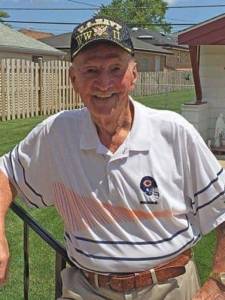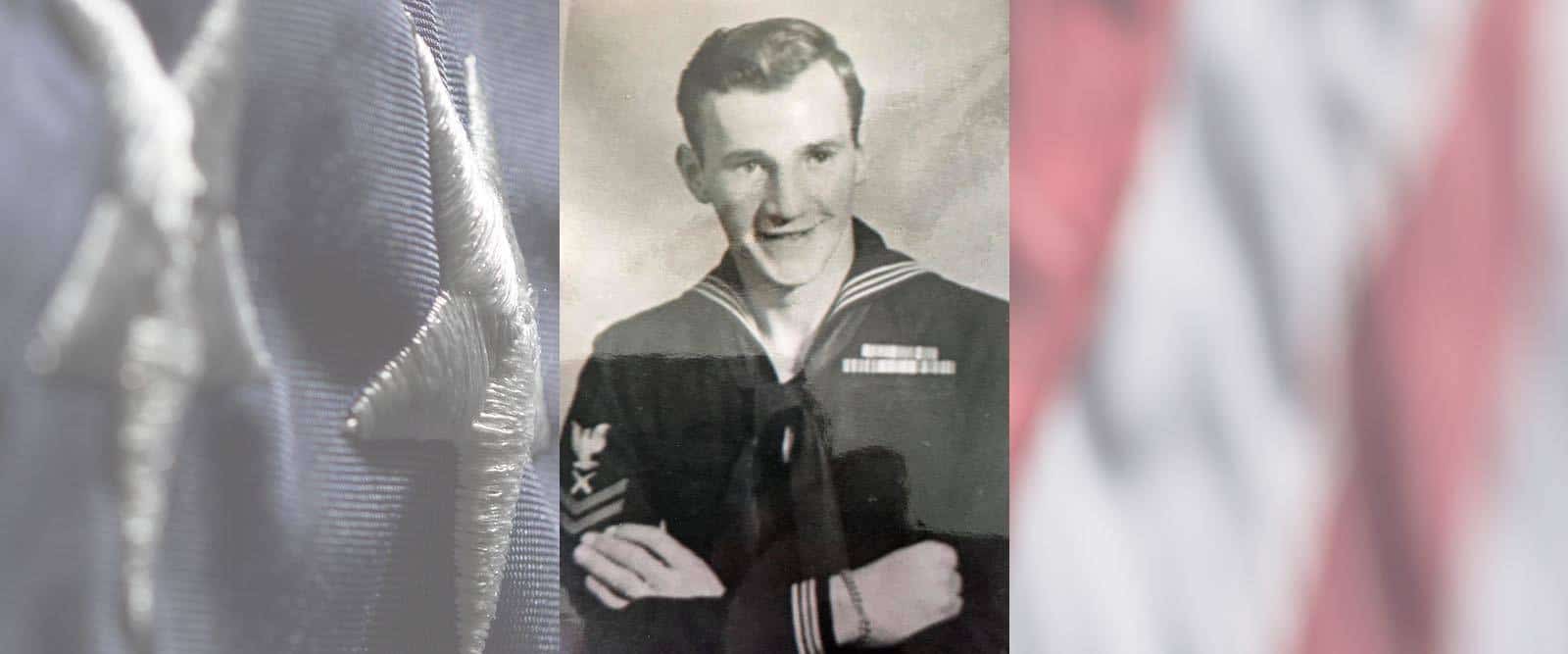U.S. Navy World War II Norridge, IL Flight date: 07/12/17
By Mark Splitstone, Honor Flight Chicago Veteran Interview Volunteer
Walter Piekosz was born in Chicago in 1925, one of nine children. His father died when Walter was ten years old, which obviously made his upbringing much more challenging. Walter attended Washburne Technical High School and was training to be a tool and die maker, but in 1942 at age 17, with World War II raging, Walter decided to join the Navy. He joined even though he didn’t know how to swim. Since he was underage, he needed his mother’s permission so she went to the recruiting office with him. Because of his technical training, the Navy wanted him to become a machinist’s mate but Walter wanted to be a sailor and he ended up going to the Navy’s gunnery school.
Walter spent his time in the Navy on Liberty ships. There were 2,700 Liberty ships built during World War II to transport supplies to both the Atlantic and Pacific theaters. Each Liberty ship was crewed with 90 merchant marines and 30 Navy personnel. The Navy personnel such as Walter were on the ships to protect them from enemy submarines and airplanes, using a three-inch gun in the bow, a five-inch gun in the stern, and eight 20mm antiaircraft guns. There were at least eight Navy men on duty at all times, watching for the ever-present threat of enemy planes and submarines. Each crew of eight took four-hour shifts, and would have two shifts every day.

Each roundtrip that a Liberty ship took would last about two months, including time to load the ship, travel to Europe, unload the ship, and return to the United States. Upon their return, they would get a brief leave, and then the process would start again. The Liberty ships would leave port and form up into 100-ship convoys, mostly made up of Liberty ships and oil tankers, but sometimes also including destroyers. While in port the duty of the Navy men was to guard the ships. During this time the sailors would get one day on and one day off which meant that Walter had time to see a bit of the countries where they stopped.
Walter served on four different Liberty ships during his time in the Navy. He made multiple trips to Europe and the Mediterranean, including stops in England, France, Italy, and Africa. He also made a stop at Omaha Beach a couple months after D-Day. There wasn’t a functioning port at the time so Walter’s Liberty ship dropped their cargo into barges which then took it to the beach.
Walter was fortunate that he never encountered the enemy, but these trips were still very dangerous. The threat of enemy submarines and planes had decreased by the time of his service, but it was still there. Walter knew other sailors and merchant marines whose ships had been sunk and he feels lucky that he was able to get through the war without encountering the fate of so many others on these vessels. Merchant marines, in fact, had the highest casualty rate of any American military organization during World War II. Danger also came in the form of the elements. The weather in the North Atlantic was often bitterly cold and since Walter’s duty involved being on the deck he and the other sailors had to bundle up in coats and masks to keep from freezing. One of the storms in the North Atlantic was so bad that the planes that were being transported on the ship’s deck were damaged and the steel plate on the 3-inch gun was crushed. Occasionally the waves were so high that they’d wash up over the decks.
One time Walter’s convoy encountered a fog bank in the North Sea and had to drop anchor. When daylight came they started moving again but another ship hit Walter’s, causing 20 feet of the gunwale to be torn off. Walter’s ship eventually started moving slowly forward, but then somebody saw through the fog that there was another ship right in front of them. They radioed up to the bridge and his ship was put in reverse, but they ended up hitting the other ship broadside. Fortunately, they weren’t going very fast but it still caused significant damage to the bow of Walter’s ship as well as a dent in the side of the other ship.
After spending over a year in the Atlantic, Walter was sent to the Pacific in 1945, which he got to by going through the Panama Canal. While in the Pacific one of their tasks was to take about 200 soldiers from New Guinea to the Philippines. He says that they got along great with the soldiers and everything went well. During the trip to New Guinea they heard that the war had come to an end. Before they returned to the United States, they were ordered to dump all their ammunition into the ocean.
When he got back to the United States Walter was able to come back to Chicago for leave. Since he only had two months left in his enlistment he was hoping to spend that time in Chicago, but instead he was ordered to go to California. When his enlistment was finally up he was asked if he wanted to join the reserves but at this point he had had enough of the Navy and decided to just go home.
After leaving the military Walter came home to Chicago and went back to work at Aetna Bearing company, which is where he had worked briefly before joining the Navy. At various times ten members of his family had worked at the company and Walter ended up working there for forty-five years. He had several jobs there over the years, including assembler, heat treat department worker, and equipment repairman. He’s proud of the bearings that the company made for military purposes and says that at one point he was taking apart a machine gun mount and found a bearing from his company inside it. Walter has now been retired for thirty years.
Two years after coming home, he got married and stayed with his wife until she died of cancer after thirty-two years of marriage. After her death, he was lucky enough to find somebody new and he’s been married to his current wife for twenty-eight years. He’s lived in the same house in Norridge for sixty years and is still very active in its upkeep, including gardening, painting, maintenance, and snow shoveling. He’s always been very active socially and while his days of going out and doing the polka with his wife don’t happen much anymore, they’ll still occasionally do the polka in their kitchen.
Walter was introduced to Honor Flight by his niece, who is a doctor at the Hines VA hospital. When he goes to the hospital, he sees the terrible physical toll that many veterans paid for their service and considers himself very lucky that he managed to get through his experiences unscathed. He thanks the Lord everyday for allowing him to “slip through the cracks” during his two years at sea.
Enjoy your well deserved honor flight, Walter!



